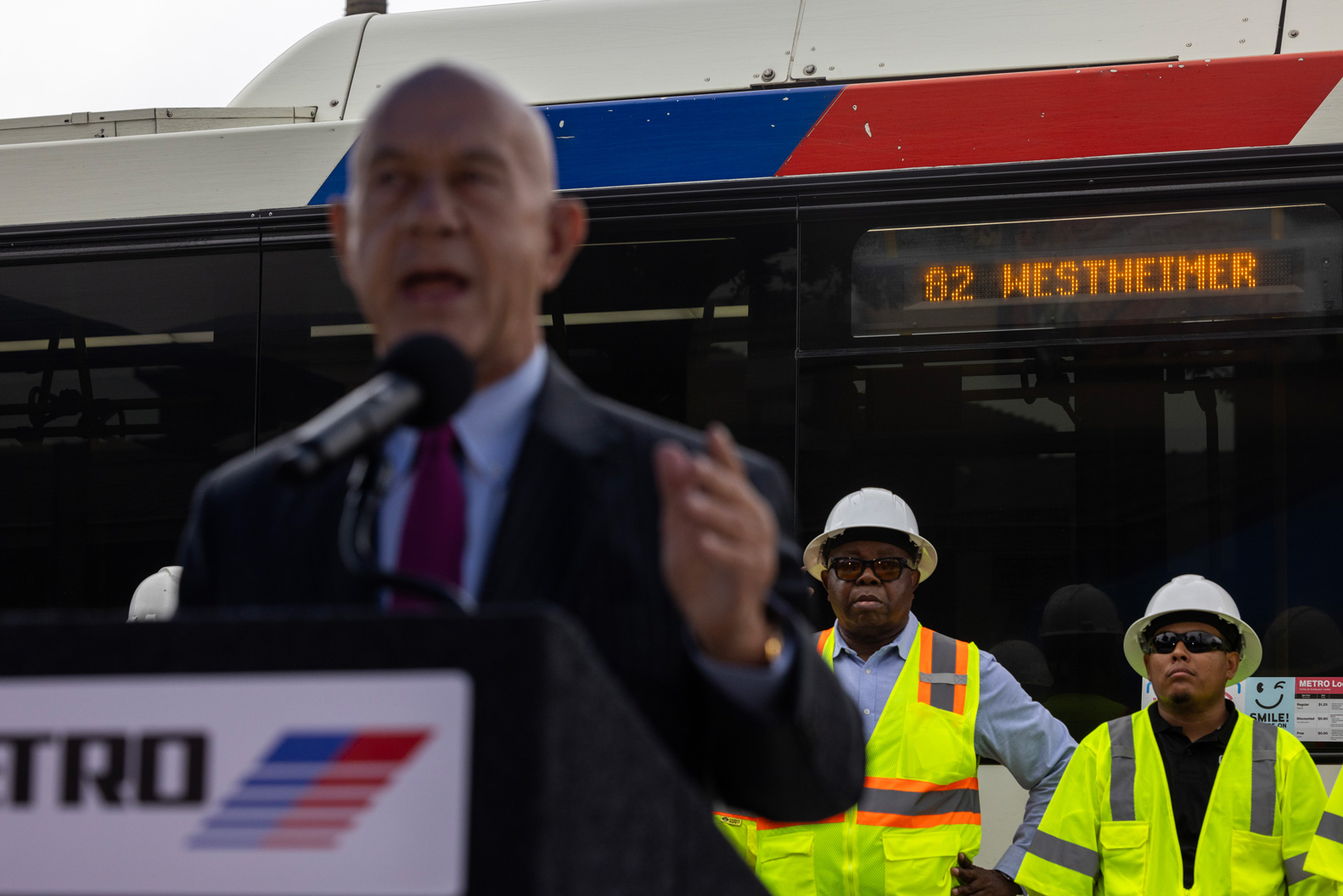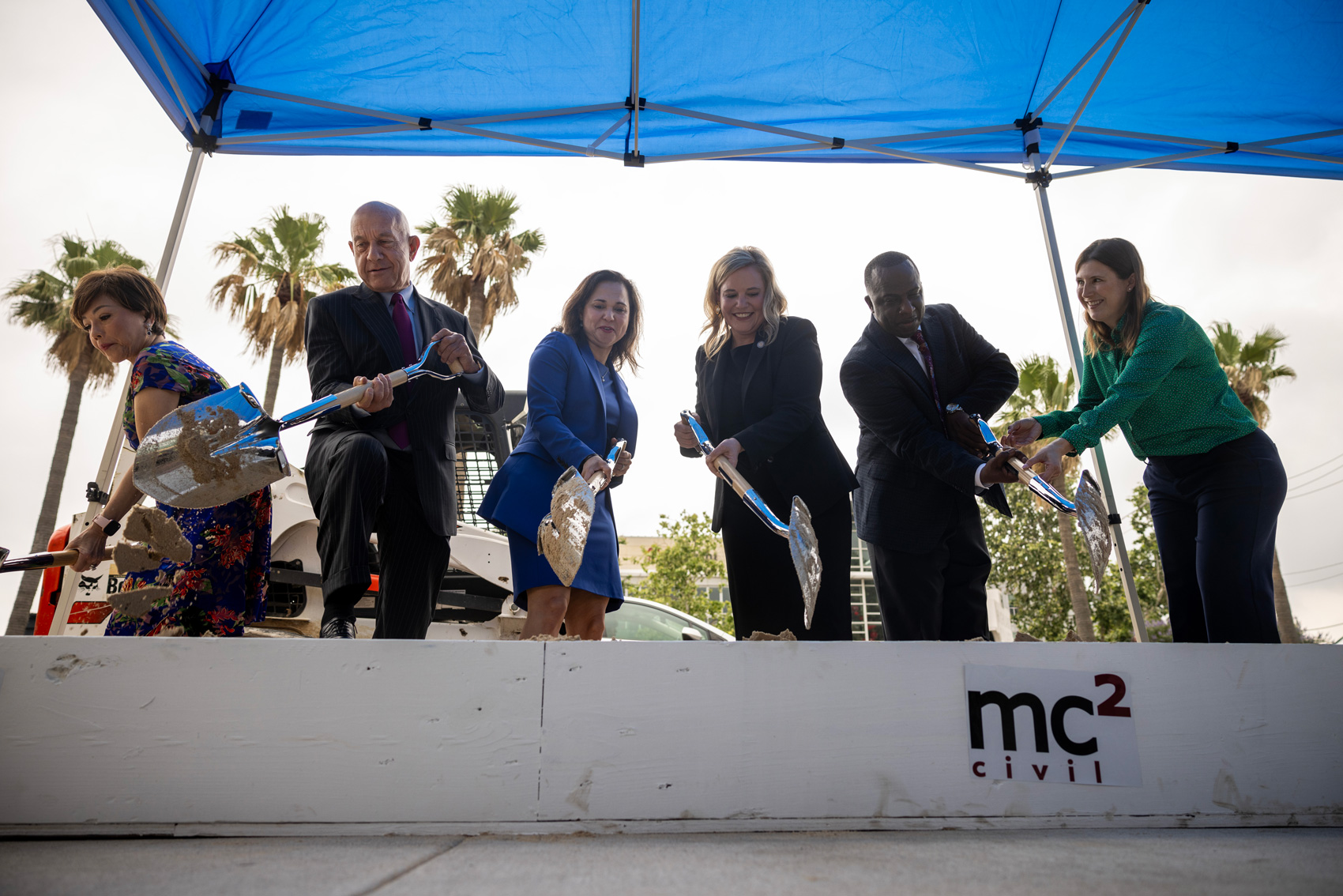|
Getting your Trinity Audio player ready...
|
Metro is beginning to steer in a different direction under Mayor John Whitmire and his appointed chair of the transit agency, pulling away from a planned expansion of bus rapid transit approved by voters, and moving toward increased roadwork instead.
“I’m here to let everyone know this is a new beginning. We’re not going to tolerate broken infrastructure, whether it’s our roads and streets or our drainage,” Whitmire said during the groundbreaking for a Metro project to repave all lanes of Westheimer from the 610 West Loop to downtown. “We’re going to fix Houston.”
An increased focus on road repairs is just one part of the new direction of Metro. In addition to putting off the bus rapid transit expansion, the agency appears ready to scrap plans for a bikeshare program.
When it comes to expansion of public transit, Whitmire and new Metro Board Chair Elizabeth Gonzalez Brock are placing their hopes in microtransit, such as expanded shuttle service and rideshare.

“Uber has set the standard for what transportation should look like in the future,” Brock said recently.
Whitmire’s approach to the Metropolitan Transit Agency of Harris County echoes his moves on transportation projects in Houston, where he has paused multimodal street development and narrower designs in favor of preserving more lanes for traffic.
The mayor has been vocal about Metro contributing more money for infrastructure, though it is unclear if that involves an increase in Metro’s General Mobility Fund.
Metro already provides up to a quarter of its sales tax revenue to Houston, Harris County and other smaller cities in the transit agency’s service area. In fiscal 2023, the contribution was $214 million, or 20.8 percent of its sales tax revenue. Of that, $148 million went to the city of Houston.
The fund shows Metro is equipped to handle some road repairs, but transportation and safety advocates say roads should not be the sole focus.
Peter Eccles, director of policy and planning for the transit advocacy nonprofit LINK Houston, said focusing on projects that do not improve walkability or street crossings would be “a wasted opportunity.”
METRONixed?
The week before the Westheimer press conference, Metro took down the webpages for the University, Gulfton, and Inner Katy bus rapid transit projects. The trio of projects would have added 75 miles of BRT as part of the agency’s METRONext program. That program was at the center of a $3.5 billion bond election approved by 68 percent of voters in 2019.
Brock points to Whitmire’s election last November, where he took just under 65 percent of the vote, as an endorsement of the mayor’s transportation plans. The mayor nominates – and City Council approves – five members of Metro’s nine-member board.
“The public authorized (the bond), they didn’t mandate it,” Brock said. “The public expects us to be very nimble and expects us to be responsible with taxpayer dollars.”
Brock is reluctant to issue the voter-approved bonds for projects that Metro leaders see as questionable investments. If the agency does issue the bonds, she said the money would be used for public safety, infrastructure, and microtransit.
Both Whitmire and Brock said the bond election occurred before changes in technology and work habits changed Houston’s public transit needs, but microtransit programs and technology are not a new development in transit technology.
“Microtransit-type operations have been around for 10, 15 years,” Eccles said. The option was considered during planning for METRONext, he said, resulting in the agency’s current curb-to-curb shuttle service.
Brock and Metro’s interim CEO and President Tom Jasien said the BRT pages were taken down due to information they thought leaned more into the side of advocacy about the projects rather than facts.
Metro Chair Elizabeth Gonzalez Brock
The public authorized (the bond), they didn’t mandate it,” Brock said. “The public expects us to be very nimble and expects us to be responsible with taxpayer dollars.
Metro did not commit to putting the webpages back up, although an update could come soon. Brock said expanding BRT still is an option, but only if it makes sense in terms of ridership and financial viability.
“Is ridership there today? I don’t think so,” Brock said, calling ridership the all-encompassing “north star” for the new Metro board’s decision making.
In an interview after the Westheimer groundbreaking, Whitmire said ridership on the current BRT Silver Line was so poor that he did not expect the city to obtain federal grants needed for additional BRT projects. As part of Metro’s upcoming service changes, the Silver Line will drop its running frequency below federal standards for a BRT line, which could jeopardize federal funding.
Using current Silver Line ridership does not make sense to Eccles.
“The other BRT lines all will work together as a network, so it’s not quite fair to judge the existing ridership,” he said.
Even without building out the BRT lines, Eccles said other bus connections could help expand the Silver Line’s ridership. LINK Houston’s recently published Equity in Transit report showed Houston’s ridership on fixed bus routes has nearly fully recovered since the COVID-19 pandemic, and 38 percent of riders surveyed wanted to see more frequent service.
The path forward for Gulfton
During Metro’s May committee meetings, staff indicated that increasing bus service in Gulfton remains a goal this summer. That is unlikely to include a commitment to the bus rapid transit line.
Whitmire and Brock took issue with the METRONext BRT projects being presented as drainage projects, with the mayor specifically saying that Gulfton does not flood.
Houston Mayor John Whitmire
“They’re largely undocumented immigrants. They just want basic services. They don’t want to be part of the Galleria,” Whitmire said. “You think they’re going to be welcome in the Galleria?”
Sandra Rodríguez, the Gulfton super neighborhood council president, disagreed, having been involved with METRONext planning since 2017.
“We do flood, and when we have heavy rains, like everywhere in Houston, we can’t get where we need to go,” Rodríguez said, citing the impact that Hurricane Harvey had on the area. She pointed out that Gulfton was one of two communities selected to help develop a citywide toolkit around sidewalk drainage, and questioned why Gulfton would be selected if the area does not flood.
“These BRT projects are street improvements, improving the infrastructure in the city of Houston,” Eccles said. “That’s what I thought we wanted Metro to be doing more of.”
The mayor, however, took it a step further following the Westheimer press conference, questioning whether Gulfton residents actually want access to an area like the Galleria.
“They’re largely undocumented immigrants. They just want basic services. They don’t want to be part of the Galleria,” Whitmire said. “You think they’re going to be welcome in the Galleria?”
The comment rankled Rodriguez.
“I don’t know who he’s been talking to in the Galleria that they don’t want people from Gulfton,” she said, pointing out that many Gulfton residents work in the Galleria as she once did. Beyond that, Gulfton residents still are consumers who shop in the Galleria.
“I really thought we were past that,” she said. “What I’m seeing, it feels like the community’s voice doesn’t matter. That all these years that we’ve invested and put into these projects and these planning efforts doesn’t matter.”
LINK Houston Executive Director Gabe Cazares said the mayor’s comments stigmatized the use of transit to only people who need it, a counterintuitive prospect to Metro’s stated focus on getting more people to choose public transit over their personal vehicles.
“As long as we continue to stigmatize using transit, then people will continue to not see that as a viable option,” Cazares said.
Brock said transit needs in Gulfton could be addressed through an upcoming partnership with RYDE, a no-cost rideshare service launched last year in the Third Ward with a focus on underserved communities. Gulfton would be a pilot area for a Metro-oriented version, according to Brock.
Houston Mayor John Whitmire
“I’m all for bikers,” Whitmire said. “Let’s do it on bike paths. It should not interfere with mobility.”
Rodriguez has doubts that a rideshare program would be a success.
“I’ve had a difficult time trying to provide just the rideshare programs that are out there now,” she said, citing a lack of trust and aversion to technology. She said families have told her they prefer to ride the bus as compared to other forms of transportation.
Cazares agreed that microtransit has a role to play in Houston, but said it would not be a “silver bullet” to make the transit system better.
“Public transportation is intended to move a large quantity of people. You are just not going to do that with microtransit,” he said. “You’re going to move a smaller amount of people in an area that is known for urban sprawl.”
No more bikeshare?
Metro interim president and CEO Tom Jasien remained noncommittal on a Metro bikeshare program, questioning whether such a service would be used for transit.
“Is it really the role of Metro to get into what turns out to be more of a recreational use?” Jasien asked, adding, “The transit component is not as strong as we originally hoped it would be.”
Last September, the Metro board authorized a contract with Quebec-based PBSC Urban Solutions to implement a bikeshare program this summer. Jasien said agency staff had been in contact with PBSC, but he was unaware of what those conversations were about. Follow-up questions about those talks were not answered.
His comments echo Whitmire's latest rhetoric on cycling in Houston.
“I’m all for bikers,” Whitmire said. “Let’s do it on bike paths. It should not interfere with mobility.”
Eccles said it was hard to distinguish between trips for recreation and transit, but over 60 percent of trips on Houston’s much-reduced BCycle system ended at a different station than where the trip started. That data suggests a majority of rides were for transit purposes, he said.
However, Jasien said a good number of people ride personal bikes and get on Metro buses. Asked if that trend would be predictive of a successful bikeshare program, Jasien said that he did not think it worked that way.
“It’s not useful to put a dock in a neighborhood in front of somebody’s house,” he said.
Eccles said a bikeshare program would be useful to improve equitable access to transit, especially in first and last mile connections.
“(People) are willing to bike two to three miles,” Eccles said. “That puts a whole lot more of our region in play with transit.”





